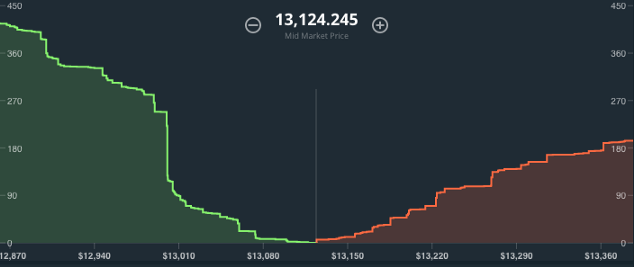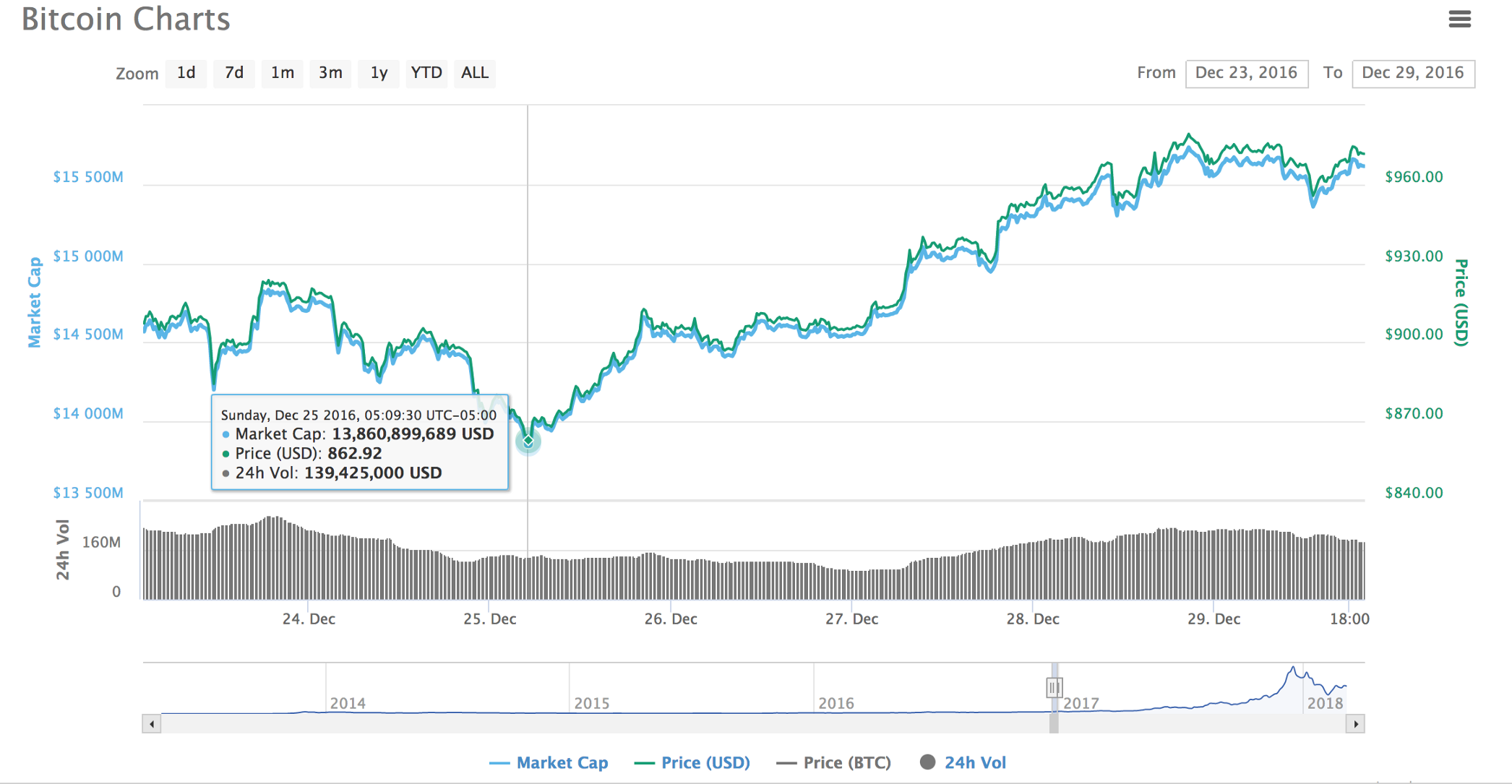Institutional investors and high-net-worth individuals (HNI) typically use over-the-counter (OTC) trading when they want to buy or sell a large amount of cryptocurrency.
That’s because while 99% of people who want to buy or sell cryptocurrency can do it directly on an exchange, placing an extremely large order on an exchange can seem daunting, and if not done right, can be a costly enterprise.
Say you’re an institutional investor trying to buy $1 million worth of Bitcoin, or you’re a startup that’s trying to sell $1 million worth of Bitcoin it raised as seed capital. If you try to place such a large buy or sell order on a cryptocurrency exchange, the order can move the entire market up or down — and lose you a fortune.
Large market orders typically go deep into the order book, leading to poor price execution.

In the example above, a 100+ BTC buy order will eat up the sell side of the order book from $13,124 all the way up to $13,220 and further up. A large sell order will execute at a price significantly higher than the mid-market price of $13,124.
Avoiding scenarios like these is the main reason why investors will trade OTC.
What is an OTC Trade?
Instead of placing a trade on a regular exchange, OTC trading is done directly between two parties. An OTC broker either supplies the trade with liquidity, or finds someone willing to take the other end of the trade. So, whats in it for you? Peace of mind.
With an OTC broker, you get a price quoted to you up front and you don’t have to think about order books, order book depth, markets moving, exchanges, trades failing and many other inconveniences of trading by yourself.
There are two main types of OTC venues:
- An inter-dealer broker, a firm that acts as an intermediary to match a buyer and seller. An inter-dealer broker will normally advertise a fixed fee to both counter parties for their match-making services.
- A principal OTC trading company, a firm that will act as the direct counter party and take on the trading risk. Principal OTC trading firms will charge the same as an inter-dealer broker or more, based on market demand and how well they can manage their risk. For example, if you ask to buy 100 BTC, they will look at the available liquidity in the market to calculate how quickly they could hedge themselves and add an additional profit (aka spread) to safely cover their risk.
While this sounds good in principle, crypto OTC trading is really opaque. On an exchange, you can see all the buy-and-sell orders in the order book. When you’re trading OTC, you don’t necessarily know what the market looks like or how big a spread an OTC broker is charging. Trading OTC provides anonymity and price stability, but it isn’t necessarily cheap.
How does an OTC trader make money? They follow the age-old adage, “buy low and sell high.” They buy from you at a lower price and sell for a higher price. This puts you at odds with the trader — every dollar they make is a dollar you lose. In game theory, this is referred to as a zero-sum game.
If you go into OTC trading blindly, you can end up getting played even worse than you would if you sold on an exchange. If you don’t know how the game is played, OTC brokers can and will profit off you. While the data on this is not publicly available, industry insiders estimate that OTC traders usually charge between 2% and 4%, so on a $10 million trade that amounts to $200k to $400k.
In this article, we’ll shed some light on the games traders play and equip you with strategies to minimize trading costs and market manipulation.
Avoid these Mistakes when Trading OTC
By placing a large order on an exchange, you’re showing your cards to the market, and the market will usually react and take advantage of you. The same goes for OTC trading. While OTC trades are hidden from the market, you can unwittingly expose your hand to brokers and they can use that information to their advantage.
Trading is a zero-sum game. The worse the rate an OTC broker can give you, the more money they make. There are a number of strategies an OTC broker can employ to skew your view of the market and profit from you.
Say that you want to sell 1,000 bitcoin and that the current exchange price for bitcoin is $10,000.
You call several brokers on the phone for pricing and give them the details of your trade:
- Broker 1: $9750 per BTC
- Broker 2: $9700 per BTC
- Broker 3: $9650 per BTC
You recognize that Broker 1 had the best offer. You call the first broker and he says the market has moved down and he’s decreased the price he’s willing to pay to $9670 per BTC. For the trade, you’re paying a hefty $330,000 compared to the exchange price!
Armed with the amount, time, and size of your trade in advance, the OTC brokers you spoke to may have done any number of things to profit from your trade. Knowing that the trade would move the market, they could front-run and adjust their own Bitcoin holdings. They could have manipulated the order book to skew your view of the market and agree to a poor rate. They could have shared the details of your trade with counter parties in their network. They could even do all of the above at the same time.
Let’s do a deep dive into the most common mistakes people make when trading OTC. We’ll explain how OTC traders profit from these mistakes, and what you can do instead.
Mistake #1: You Shopped Around
When trying to execute an OTC trade, people commonly believe that the best way to find a good deal is to shop around by calling multiple brokers on the phone and ask around for rates. That way they can go with the cheapest option.
The problem is that the more people you tell about your trade, the more likely it is that they’ll use that information against you.
For example, say that one of the brokers you called was an inter-dealer broker. After you call them for the quote, they’ll talk to people they know to find a counter party for the trade. Now the network knows there’s a highly motivated seller. The broker, or the counter parties, can remove their buy orders from the market, moving the price of Bitcoin lower, so they can secure a more favorable rate once the large trade executes.
While you might think shopping around helps you find the best deal, you often end up showing your hand and brokers can turn that information against you.
You could try this instead: Find a trusted partner before you need to do a trade by window shopping: Try calling the brokers for rates much ahead of time before you really need to trade (maybe every day for a week or so). This way, the brokers won’t know whether you are window shopping or ready for a trade. On the day of the trade, just focus on one to two brokers and execute the trade quickly.
Also, if you are going to call multiple brokers, talk to them simultaneously (say via a chat) so you can get the rate fairly close to each other. This way, you should be able to trade before that information moves the market.
Mistake #2: You Showed Your Hand
Even if you only call a single broker on the phone with the details of your trade, that gives them enough information to front-run you. Say that you call an individual broker and say that you want to sell 1,000 BTC. You’ve just shown your hand and that information can be used against you.
The moment you hang up the phone, the broker rushes to sell some of his or her own Bitcoin.
If you do go with that broker, he or she can simply buy Bitcoin back from you at a lower rate. Even if you go with a different broker, since your 1,000 BTC trade will move the market down, the broker you called can simply buy Bitcoin back from the market at a cheaper price.
Either way, the broker gets the upper hand because you’ve spilled the beans around your trade.
You could try this instead: When you call an OTC broker on the phone, ask them to provide both buy and sell rates (even if you are only selling) for 1,000 BTC. This way, the broker does not know how to front run you (should they buy more because price will increase or should they sell more because price will decrease).
Asking for both buying and selling rate has an additional benefit: you’re getting the broker to show his or her hand instead of exposing your own. You can look at the difference (the spread) between the buy-and-sell rates and that difference is a good estimate of the broker’s profit margins. This will also encourage the broker to reduce the spread and thus lower your cost of trading.
Mistake #3: You were Predictable
Another common mistake people make with OTC is behaving predictably. Brokers can exploit patterns of behavior to their advantage.
Let’s say that every time you want to make an OTC trade, you call the same couple of brokers on the phone and ask for a rate. You do this each week over the course of a month.
OTC brokers are taking notes on how you behave and they’ll know that when you call, you’re talking to other brokers and looking for the most competitive rate.
To lock in your business, an OTC broker might give you a really attractive window price for your trade the first time that you call. After you’ve spoken to other brokers, you’ll go back because the first broker gave you the most competitive rate. That’s when they stick you with the real rate—which, needless to say, is substantially higher. Since this broker gave the best rate initially, you’re more likely to execute your trade with him even if the final rate is higher.
You could try this instead: Don’t be predictable with your OTC trades. Rotate the order in which you call the brokers and change the brokers you call. If an OTC broker gives you a rate that sounds too good to be true, it probably is. Call their bluff and ask them to lock in that rate for you.
Another thing to keep in mind is timing. Say you call on the first of every month, or every Tuesday, at say 2pm — this information can also be used by brokers to their advantage. Keep changing the times when you call to execute the trade.
Mistake #4: You Bought or Sold the Full Amount
If you’re trying to buy or sell 1,000 BTC OTC, don’t make the mistake of trying to stuff the full amount into a single trade. The rate that you get for selling 10 BTC will be much better than the rate you get for selling 10,000 BTC.
With a large trade, they know you will go deep in the order book and thus the rate you will get even on exchanges won’t be strong. Further, there’s always the risk that the market will move and that the price will slip. OTC brokers price this risk into the rate that they give you. For a sell order of 10,000 BTC at a price of $10,000 per BTC, a 10% upward movement in the price can cost millions. OTC traders don’t share the same risk because they’re trading all the time — but they’ll still price this risk into your trade to widen profit margins.
You could try this instead: When you call an OTC broker on the phone, ask them to provide both buy and sell rates for 1,000 BTC, 500 BTC, and 100 BTC. This gives you a sense of how much the depth is costing you. You can then decide what is the right amount / price for you.
Another option is to not buy or sell the full amount of crypto in a single OTC trade. Split your order into several smaller trades of 100 BTC each. In this case, it does make to call multiple brokers and sell 100 BTC each; this way you can liquidate faster and get a favorable rate of trading a smaller amount.
Mistake#5: OTC Trading in a Slow Market
Another common mistake when OTC trading is trying to place trades in a slow market.

Let’s say that you want to make an OTC trade on Christmas Day (or another weekend or holiday). Because it’s a holiday, there will be a lot less activity on the market and lower volume than almost any other day of the year. This means the order book will also be very sparse and many OTC brokers won’t be around. This will generally mean the broker can charge you a higher rate because you don’t have that many opportunities.
You could try this instead: For larger trades, it is best to OTC trade when there is a decent level of activity in the market before placing an OTC trade.
Mistake #6: OTC Trading in a Volatile Market
Avoiding to trade in slow markets doesn’t mean you go the other extreme and trade when market is highly volatile with high fluctuations in price.
In theory, the market has higher volume during periods of high volatility because there’s a higher level of activity. This volatility comes higher risk because you really don’t know whether you can get your trade executed in a timely manner. But remember that OTC brokers charge a risk premium when they price a trade. If the market is volatile, it’s harder to know the price a trade will execute as, and OTC traders will charge a higher risk premium accordingly.
You could try this instead: Avoid OTC trading when the market is highly volatile. Given volatility in the markets in recent times, this is easier said than done.
Play Your Cards Close to the Chest
While OTC gives you a peace of mind, that peace of mind often comes at a high cost because you’re dealing with a middleman who’s active in the market.
When you trade OTC, you need to account for the explicit fees that you pay the broker along with the soft costs you’ll incur by sharing information with an active market participant. Minimize the information you share to minimize your exposure to manipulation.
Above all, it helps to remember these three very important techniques when trading OTC:
- In general, don’t be predictable. Ask for buy and sell quotes. Ask for multiple quantities.
- Don’t share the exact time you want to trade, or the full quantity. Call at different times with different quantities.
- Do your homework. Know whom you want to trade with and shop only when you are ready to execute the trade, and trade quickly.
Finally, there is a do-it-yourself option. There are a number of tools (that OTC traders use themselves) available on the market that are making it easier for traders to buy and sell crypto OTC on their own. Stay tuned for more on this topic (or email us if you can’t wait)!
The above references an opinion and is for informational purposes only. It is not intended as and does not constitute investment advice, and is not an offer to buy or sell or a solicitation of an offer to buy or sell any cryptocurrency, security, product, service or investment. Seek a duly licensed professional for investment advice. The information provided here or in any communication containing a link to this site is not intended for distribution to, or use by, any person or entity in any jurisdiction or country where such distribution or use would be contrary to law or regulation or which would subject SFOX, Inc. or its affiliates to any registration requirement within such jurisdiction or country. Neither the information, nor any opinion contained in this site constitutes a solicitation or offer by SFOX, Inc. or its affiliates to buy or sell any cryptocurrencies, securities, futures, options or other financial instruments or provide any investment advice or service.



